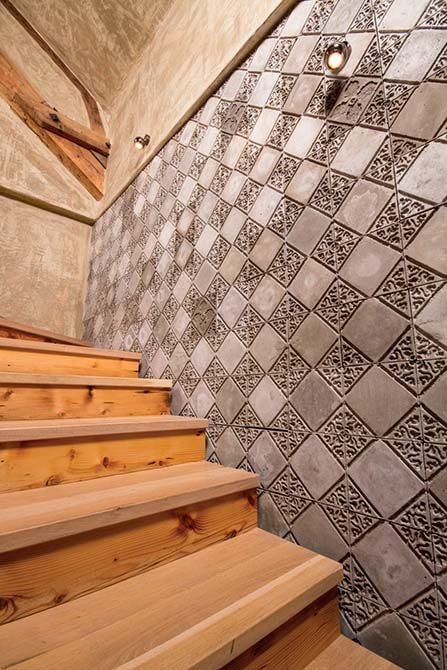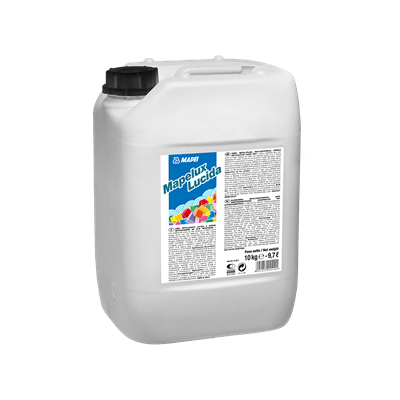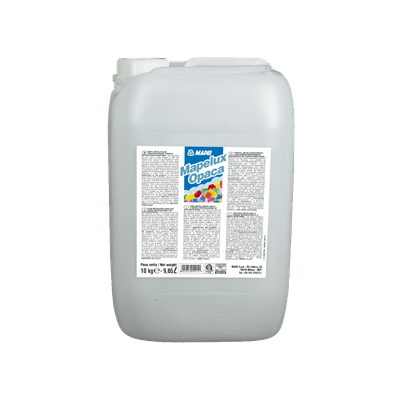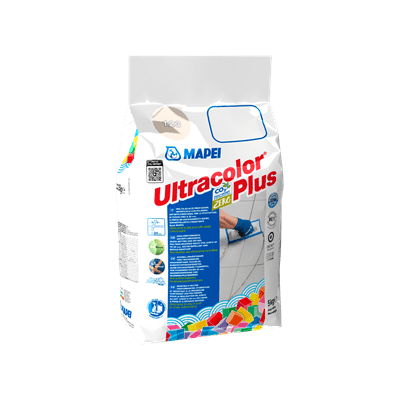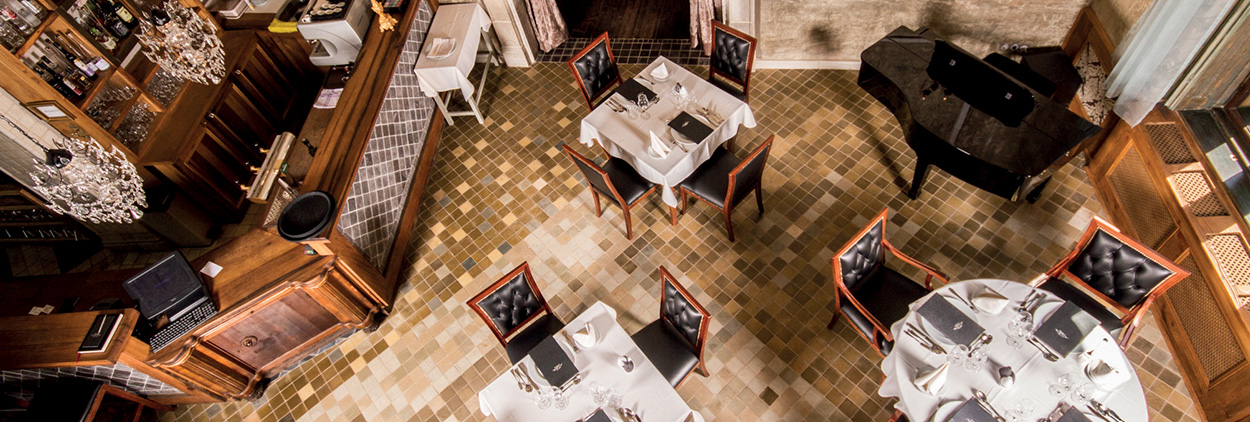
48 Restaurant & Bar in Hungary
In Kecskemét a building dating back to the beginning of the 1900’s has been renovated using appropriate adhesives for top of the range tiles.
The restauration of a building of historical interest requires attention to details and long studies. In this case the works lasted two years and required special care for all interiors and exteriors. For the internal walls and floors, the interior designer and client chose tiles from a Hungarian company specialised in the production of tiles and mosaics with decorative features and unique colours. The manufacturer of the tiles recommended using Mapei products and systems – with whom it had already worked on other sites with great success – not only to install the tiles in various sizes and thicknesses, but also to install and waterproof 600 m2 of substrate.
“My initial reaction when I saw this building for the first time was of amazement. Since it had been built it had already undergone so many changes and now I was the one behind yet another change in use! There are traces of the past, present and future to be found in every corner of this building. It has a very unique history which deserves to be told, layer after layer, just like the history of the piazza and the city where it is located. The building should really have been demolished but a committee decided to salvage it and, by working together, we managed to create a new world from the ruins of the old world”. The words of Ottó Hoffer, the interior designer who designed all the interiors for this new restaurant and bar in the Hungarian city of Kecskemét, are a perfect example of his commitment when taking on the renovation of this building dating back to the beginning of the last century and which, over the years, had been extended and renovated a number of times. Before the most recent intervention two years ago, the building was in a state of disrepair and general decline. Also, the numerous renovation works carried out in the past had mixed its original Secession style with additions and demolitions and its past glory was something that only the imagination could have envisaged.
BESPOKE TILES AND DECORATIONS
For the internal walls and floors, the interior designer and client chose tiles from a Hungarian company specialised in the production of tiles and mosaics with decorative features and unique colours. The manufacturer of the tiles recommended using Mapei products and systems – with whom it had already worked on other sites with great success – not only to install the tiles in various sizes and thicknesses, but also to install and waterproof 600 m2 of substrate.
The substrate was made from TOPCEM, a special hydraulic binder for normal-setting, rapid-drying, controlled shrinkage screeds. Thanks to the skill of the tilers and the quality of the products, once the screed was cured and dry, it was ready for the next stage of the intervention without having to do anything else to level off the installation bed.
For the bar and the restaurant area, 2 cm thick Art Déco tiles were chosen in two different formats (10x10 cm and 12.5x12.5 cm). KERAFLEX MAXI S1 high-performance, non-slip cementitious adhesive with extended open time was used to install the tiles. The final phase was to fill the grout lines with ULTRACOLOR PLUS high performance, rapid-drying mortar which, over the years, remains perfectly water-repellent and resistant to the formation of mould. Preference was given to MAPESIL LM silicone sealant to make the expansion joints.
In the restaurant area there is an English style fireplace and surround. To comply with safety regulations, a wooden insert was installed in the old fireplace, a special hearth designed to be placed in old fireplaces during restoration work. The new structure was made from Ytong concrete blocks which were reinforced with a cementitious mortar, reinforced with MAPENET 150 alkali-resistant glass fibre mesh before installing the tiles. The natural stone surface was bonded with ADESILEX P9, while for the grout lines, which needed to have a rustic look, preference was given to KERACOLOR RUSTIC high performance mortar, a product manufactured in Hungary exclusively for the Hungarian market, which has good compressive and flexural strength and resistance to abrasion and is used to fill internal and external grout lines from 5 to 50 mm wide.
THE PROBLEM OF DAMP IN THE WASHROOMS AREA
Some of the walls in the washrooms and in the stairwell were tiled with square Pietra Kvàder tiles which look like natural stone (21x21 cm). Before installing the tiles, the surface was treated with PRIMER G synthetic resin-based primer in water dispersion diluted 1:2 with water. PRIMER G is a product that encourages adhesion, anchors surface dust and evens out the absorbency of substrates before bonding tiles. The tiles were installed with ADESILEX P9 and again grouted with KERACOLOR RUSTIC in the stairwell and with ULTRACOLOR PLUS in the washrooms. The joints were sealed with MAPESIL LM.
The public washrooms were located in the original vaulted cellar but had problems of damp and had often suffered from flooding. They had been badly damaged by water in the past and the surface needed to be coated with a waterproofing membrane before installing the tiles. So, after installing new screeds made from TOPCEM, the waterproofing work could be carried out. The first step was to create fillet joints between the floors and walls with MAPEBAND alkali-resistant, rubber-backed felt tape.
MAPELASTIC FOUNDATION two-component cementitious mortar, which is used to waterproof facing walls, was applied on the surfaces, and this was also reinforced with MAPENET 150 mesh.
Two types of tiles were installed on the walls: the Victorian model in black for the men’s washrooms and the Moorish model in terracotta for the ladies’ washrooms. For the floors, on the other hand, preference was given to the Art Déco model of tiles in a similar size (20x5 cm) to the planks used for the wooden flooring. The wall tiles were installed with ADESILEX P9 non-slip cementitious adhesive and the floor tiles were installed with KERAFLEX MAXI S1.
In order to create a rustic yet elegant look, it was very important to choose the right grouting product: KERACOLOR GG polymer-modified cementitious mortar proved to be the perfect choice. This product is resistant to acids and is ideal for grout lines from 4 to 15 mm wide.
The Terracotta Castle model tiles, characterised by their decorative textured finish, were installed with ADESILEX P9 in the stairwell leading to the gallery.
FINAL TREATMENT
The efflorescence that had formed on the existing surfaces dressed with natural stone was removed with KERANET acid-based cleaner, which is available in both liquid form (15% in solution) and in a concentrated powder form. MAPECRETE STAIN PROTECTION was then applied over the stone, an hydro-oil repellent and anti-stain treatment made of modified organic polymers in a watery solution for surfaces in concrete, stone material and natural stone.
For the final treatment of the floor tiles, the designers were looking for a finish that was neither shiny nor matt, but rather a satin finish, which is not particularly easy to obtain. Mapei Technical Services proposed mixing MAPELUX OPACA and MAPELUX LUCIDA, double-reticulating, high-strength metallic waxes with a matt and shiny finish, which is used to protect floors exposed to highly intense traffic, such as in this case. After applying two coats of the wax mixture, both the client and the designers said that it was “….exactly the finish we were looking for, as if we had gone back in time!”
For further information see www.mapei.hu





